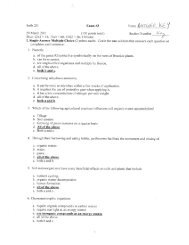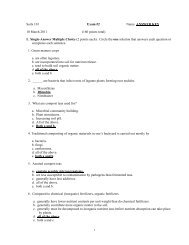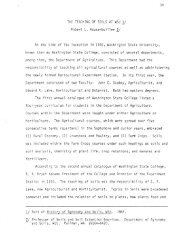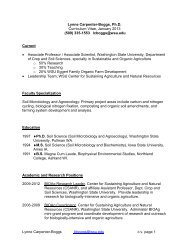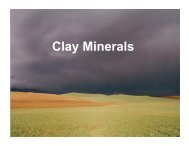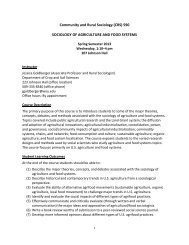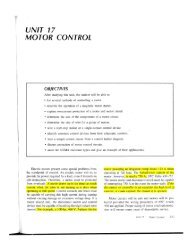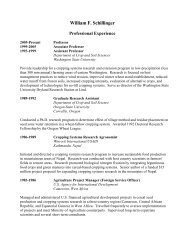2012 Dryland Field Day Abstracts - Dept. of Crop and Soil Sciences ...
2012 Dryland Field Day Abstracts - Dept. of Crop and Soil Sciences ...
2012 Dryland Field Day Abstracts - Dept. of Crop and Soil Sciences ...
You also want an ePaper? Increase the reach of your titles
YUMPU automatically turns print PDFs into web optimized ePapers that Google loves.
Variety History Page 19<br />
Alaska-81 – Released in 1984 by USDA-ARS, seeds are dark green, round <strong>and</strong> smooth with green cotyledons. Immune to pea seed borne mosaic<br />
virus <strong>and</strong> resistant to Fusarium wilt race 1.<br />
Joel – A medium sized, green cotyledon dry pea released in 1997 by USDA-ARS. The variety has improved green pea color quality <strong>and</strong> has resistance<br />
to powdery mildew <strong>and</strong> Fusarium wilt race 1.<br />
Lifter – A green cotyledon dry pea released in 2001 by USDA-ARS. The variety has multiple disease resistance, persistent green color <strong>of</strong> the seeds<br />
<strong>and</strong> yields are improved over Columbian <strong>and</strong> Joel. It has a dwarf plant habit with normal leaves.<br />
Franklin – A green cotyledon dry pea released in 2001 by USDA-ARS. The variety is resistant to Fusarium wilt race 1, pea enation mosaic virus, <strong>and</strong><br />
powdery mildew.<br />
Stirling – A green cotyledon dry pea released in 2004 by USDA-ARS. It is a semi leafless st<strong>and</strong> up variety with resistance to Fusarium wilt race 1 <strong>and</strong><br />
powdery mildew.<br />
Medora – A green cotyledon dry pea released in 2006 by USDA-ARS. The variety was released for improved plant height <strong>and</strong> lodging resistance. It<br />
also has resistance to powdery mildew.<br />
Spring Yellow Peas<br />
First <strong>and</strong> Best – Was one <strong>of</strong> the first yellow pea varieties grown in the Palouse region.<br />
Latah – Released in 1977 by USDA-ARS. The variety was a pure line selection from First <strong>and</strong> Best.<br />
Umatilla - Released in 1986 by USDA-ARS, 'Umatilla' is about 15 cm shorter <strong>and</strong> is higher yielding when compared to Latah. Resistant to Fusarium<br />
wilt race 1 <strong>and</strong> tolerant to pea root rot.<br />
Shawnee - A large seeded, yellow cotyledon dry pea released in 1997 by USDA-ARS. 'Shawnee' has large seed size, bright yellow seed color <strong>and</strong><br />
resistance to powdery mildew.<br />
Fallon - A large seeded, yellow cotyledon dry pea released in 1997. The variety is resistant to powdery mildew <strong>and</strong> with a semi-leafless upright<br />
growth habit.<br />
Winter Peas<br />
Common Austrian Winter Pea – The original Austrian Winter pea was grown extensively in the Palouse region for green manure plow down since<br />
the early 1900s. Improved types such as Melrose <strong>and</strong> more recently Granger have replaced the variety.<br />
Melrose – An improved Austrian Winter pea released by the University <strong>of</strong> Idaho in 1978.<br />
Granger - A semi leafless Austrian winter-type pea released in 1996 by USDA-ARS.<br />
Specter – A white flowered winter pea released by USDA-ARS in 2004 as a feed pea. The variety is semi leafless <strong>and</strong> has yellow cotyledons. It is<br />
resistant to Fusarium wilt race 1 <strong>and</strong> 2.<br />
Windham – A white flowered winter pea released by USDA-ARS in 2006 as a feed pea. The variety is semi leafless, has a dwarf plant habit, lodging<br />
resistance <strong>and</strong> has yellow cotyledons. It is resistant to Fusarium wilt race 1.<br />
Lynx – A white flowered, semi-leafless, semi-dwarf winter pea released by USDA-ARS in <strong>2012</strong> for wildlife food plots.<br />
Lentils<br />
Brewer Types<br />
Chilean – A large seeded yellow cotyledon variety introduced into the region in 1920.<br />
Brewer – A large seeded yellow cotyledon lentil with larger <strong>and</strong> more uniform seeds, released in 1984 by USDA-ARS.<br />
Merrit – A large seeded yellow cotyledon variety released by USDA-ARS in 2003. The variety has seed coat mottling <strong>and</strong> is expected to replace<br />
Brewer.<br />
Laird Types<br />
Tekoa – A large seeded yellow cotyledon variety released by USDA-ARS in 1969. The variety had an absence <strong>of</strong> seed coat mottling.<br />
Palouse – Released by USDA-ARS in 1981. The variety has large seed size <strong>and</strong> an absence <strong>of</strong> seed coat mottling.<br />
Pennell – A large seeded yellow cotyledon variety released by USDA-ARS in 2003. The variety lacks seed coat mottling.<br />
Mason – A large seeded, yellow cotyledon lentil released in 1997 by USDA-ARS. Mason has large seed size <strong>and</strong> no seed coat mottling.<br />
Rivel<strong>and</strong> – A large seeded yellow cotyledon lentil released in 2006 by USDA-ARS. Rivel<strong>and</strong> has extremely large seed <strong>and</strong> lacks seed coat mottling.<br />
Small-seeded Types<br />
Pardina – A small, yellow cotyledon type cultivar with brown <strong>and</strong> speckled seed coats. It was introduced by the lentil industry from Spain <strong>and</strong> is now<br />
being produced extensively in the Palouse.<br />
Richlea – Developed <strong>and</strong> released in Canada. The variety has medium sized seeds with yellow cotyledons <strong>and</strong> an absence <strong>of</strong> seed coat mottling. It is<br />
high yielding.<br />
Eston – Developed <strong>and</strong> released in Canada. The variety has small seed size with yellow cotyledons.




